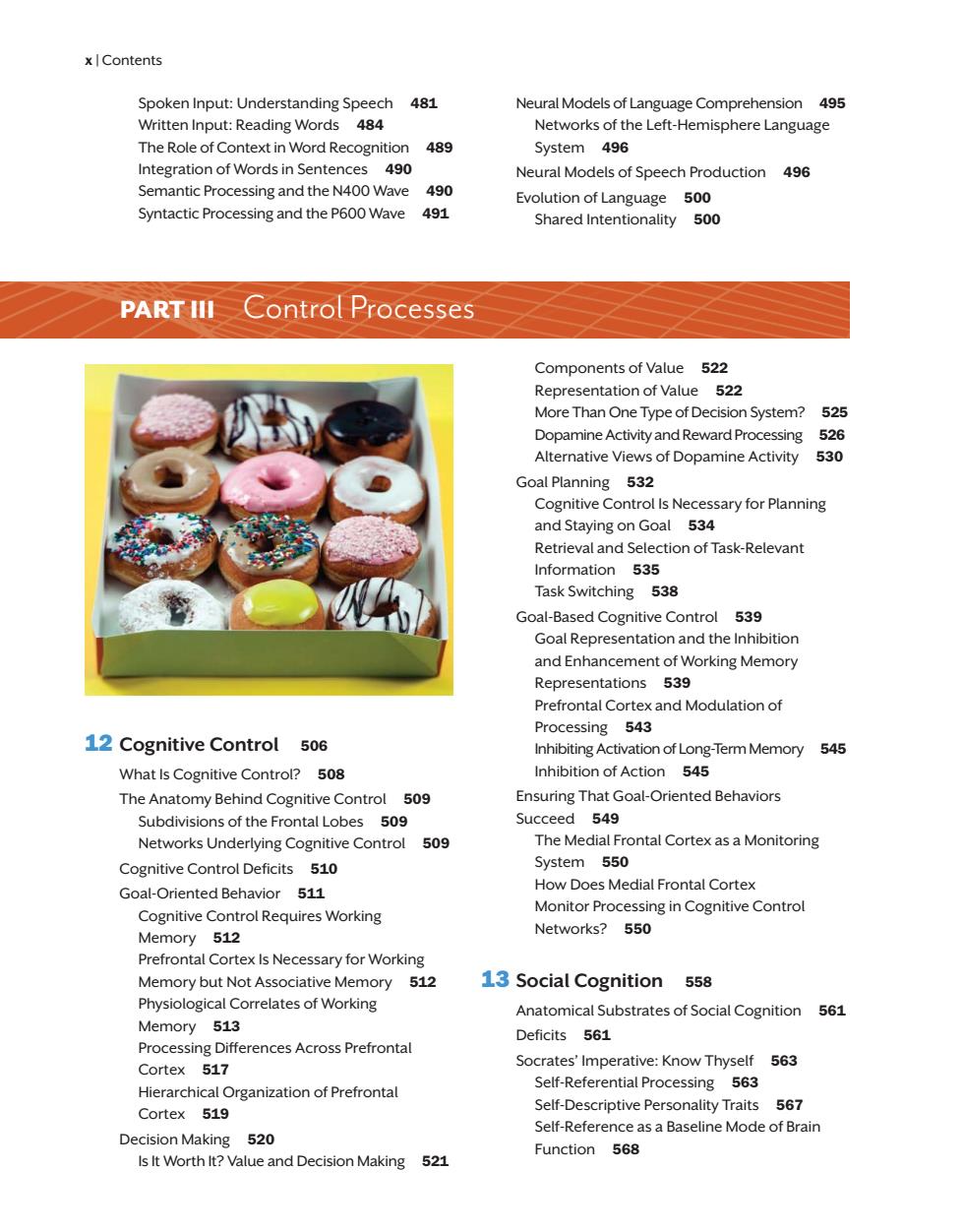正在加载图片...

xIContents Spoken Input:Understanding Speech 481 Neural Models of Language Comprehension 495 Written Input:Reading Words 484 Networks of the Left-Hemisphere Language The Role of Context in Word Recognition 489 System 496 Integration of Words in Sentences 490 496 ing and the N400 Wav 4 Neural Models of Speech Production Evolution of Language 500 Syntactic Processing and the P600 Wave 9 Shared Intentionality 500 PART III Control Processes Components of Value 522 ntation of Value 522 on System? Dopamine Activity and Reward Processing Alternative Views of Dopamine Activity 530 Goal Planning 532 Cognitive Control Is Necessary for Planning and Staying on Goal 534 nd s election of Task-Relevant 53 Task Switching 538 Goal-Based Cognitive Control 539 Goal Representation and the Inhibition and Enhancement of Working Memory resentatio 539 x and Modulation of 12 Cognitive Control 506 nhibiting Acti on of Long-Term Memory 545 What Is Cognitive Control?508 Inhibition of Action 545 The Anatomy Behind Cognitive Control 509 Ensuring That Goal-Oriented Behaviors 09 Succeed 549 Networks Underlying Cognitive Control 509 The Medial Frontal Cortex as a Monitoring Cognitive Control Deficits 510 System Goal-Oriented Behavior 511 How Does Medial Frontal Cortex Monitor Processing in Cognitive Control Cognitive Co trol Requires Working Memory 512 Networks?550 Prefrontal Cortex Is Necessary for Working Memory but Not Associative Memory 512 13 Social Cognition 558 Physiological Correlates of Working Anatomical Substrates of Social Cognition 561 Memory 513 Deficits 561 Processing differences across prefrontal Cortex 517 e:Know Thyself 563 563 Cortex 519 Self-Descriptive Personality Traits 567 Self-Reference as a Baseline Mode of Brain Decision Making 520 Is It Worth It?Value and Decision Making 521 Function 568x | Contents Spoken Input: Understanding Speech 481 Written Input: Reading Words 484 The Role of Context in Word Recognition 489 Integration of Words in Sentences 490 Semantic Processing and the N400 Wave 490 Syntactic Processing and the P600 Wave 491 Neural Models of Language Comprehension 495 Networks of the Left-Hemisphere Language System 496 Neural Models of Speech Production 496 Evolution of Language 500 Shared Intentionality 500 PART III Control Processes 12 Cognitive Control 506 What Is Cognitive Control? 508 The Anatomy Behind Cognitive Control 509 Subdivisions of the Frontal Lobes 509 Networks Underlying Cognitive Control 509 Cognitive Control Defi cits 510 Goal-Oriented Behavior 511 Cognitive Control Requires Working Memory 512 Prefrontal Cortex Is Necessary for Working Memory but Not Associative Memory 512 Physiological Correlates of Working Memory 513 Processing Differences Across Prefrontal Cortex 517 Hierarchical Organization of Prefrontal Cortex 519 Decision Making 520 Is It Worth It? Value and Decision Making 521 Components of Value 522 Representation of Value 522 More Than One Type of Decision System? 525 Dopamine Activity and Reward Processing 526 Alternative Views of Dopamine Activity 530 Goal Planning 532 Cognitive Control Is Necessary for Planning and Staying on Goal 534 Retrieval and Selection of Task-Relevant Information 535 Task Switching 538 Goal-Based Cognitive Control 539 Goal Representation and the Inhibition and Enhancement of Working Memory Representations 539 Prefrontal Cortex and Modulation of Processing 543 Inhibiting Activation of Long-Term Memory 545 Inhibition of Action 545 Ensuring That Goal-Oriented Behaviors Succeed 549 The Medial Frontal Cortex as a Monitoring System 550 How Does Medial Frontal Cortex Monitor Processing in Cognitive Control Networks? 550 13 Social Cognition 558 Anatomical Substrates of Social Cognition 561 Defi cits 561 Socrates’ Imperative: Know Thyself 563 Self-Referential Processing 563 Self-Descriptive Personality Traits 567 Self-Reference as a Baseline Mode of Brain Function 568 00i_xviii_Cogneu_4e_FM.indd x 8/1/13 1:22 PM